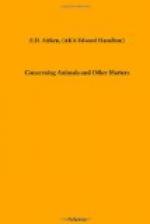[Illustration: A GREAT CATHOLIC CONGRESS OF DISTINGUISHED EARS.]
But go to the timid beasts that spend their lives on the ground among grass and brushwood and woods and coppices, where murderous foes are prowling unseen, and you will see ears indeed—expansive, tremulous, turning lightly on well-oiled pivots, and catching, like large sea-shells, the mingled murmur of rustling leaves and snapping twigs and chirping insects and falling seeds, and the slight, occasional, abrupt, fateful sound which is none of these. It is impossible, no doubt, for us ever to think ourselves into the life which these beasts live—moving, thinking and sleeping in a circumambient atmosphere of never-ceasing sound; sitting, as it were, at the receiving station of a system of wireless telegraphy, and catching cross-currents of floating intelligence from all quarters, mostly undiscernible by us if we listened for it, but which they, by long practice, instantly locate and interpret without conscious effort.
The zoologist classifies them under many heads. The field mouse and rabbits are rodentia, the deer ungulata, the kangaroos marsupialia. In my museum they are all one family, and their labels are their ears. In these days of international conferences, parliaments of religion, pan-everything-in-turn councils, might we not arrange for a great catholic congress of distinguished ears? What a glow of new life it would shed upon our straitened, traditional ways of thinking about the social problems of our humble fellow-creatures! I would exclude the eared owls, whose ears are a mere sport of fashion, like the hideous imitations of birds’ wings which ladies stick on their hats.
But just when this peep into the rare show of Nature is lifting my soul into sublimity, I am brought down to the base earth again by an exception. This is the plague of all high science. You design a stately theory, collect from many quarters a wealth of facts to establish it with, and have arranged them with cumulative and irresistible force, when some disgusting, uninvited case thrusts itself in on your notice and refuses to fit into your argument at all. In this instance it is “my lord the elephant.” That he has no need to concern himself about any bloodthirsty beast that may be lurking in the jungle is not more obvious than that his ears are the biggest in the world. Now there are two ways of getting rid of an obstruction of this kind. One is to betake yourself to your thinking chair and pipe and to rake up the possibilities of the Pleiocene and Meiocene ages, and prove that when the immense ear of the elephant was evolved there must have been some carnivorous monster, some sabre-toothed tiger or cave bear, which preyed on elephants.




